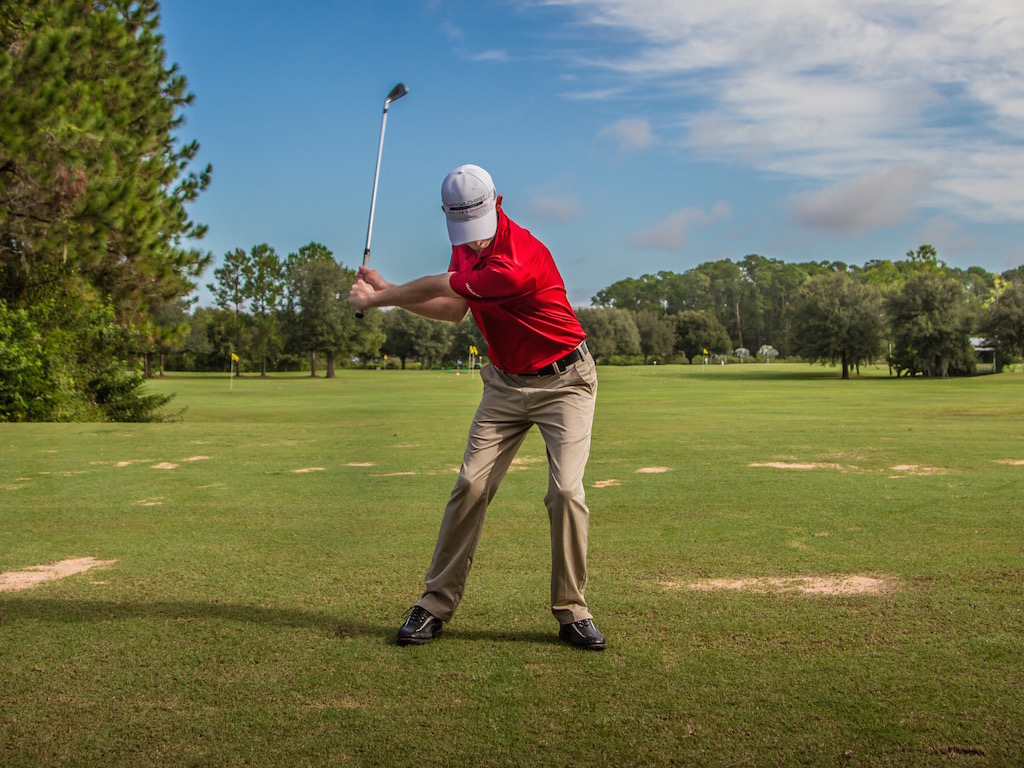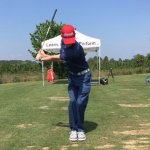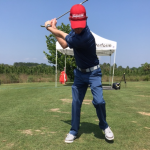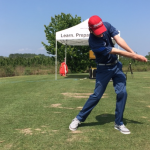Instruction
Build more speed into your swing

One of the key requests I get from golfers is the need for more distance in their games. There are many different factors that go into increasing power and speed in one’s swing, and you won’t just increase club head speed by feeling like your actually swinging the golf club faster. I have personally found that when I attempt to swing the golf club faster, I’m only able to pick up about 1 mph on Trackman. I also find that when I try to do this I loose control. My face-to-path differential increases, which produces more curvature on the golf ball, and I’m not striking the center of the face with the same consistency. This produces poor results!
With that being the case, how can one increase their speed and add power without just trying to swing the golf club faster?
There are two keys I like to focus on when increasing clubhead speed:
- Effective usage of the ground in the downswing
- Increasing overall lag
These two are mutually exclusive in my mind. When a player can put more pressure into the ground in the beginning of the downswing, and then use the ground as a spring board through impact it will do a few things for the player. Often times, it will help increase lag, or give the club a lighter feel in the transition. When the club is “lighter,” or more on plane, it can often be moved at a faster rate. Depending on the player, it can also improve swing direction.
I recently was part of a teaching summit that had many of the world’s top instructors present. During this summit, a gentleman gave a presentation relating to ground forces. He found that the longer hitters he studied managed to come close to doubling their weight in pressure in pounds as they began their transition into the downswing. Those players would also have the least amount of pressure in pounds at impact. That means they squat early in the transition, and then spring upwards through impact.
A good example of this can be seen in Rory McIlroy’s swing.
As he begins the downswing, he will appear to squat into the ground and then spring upwards through impact. He is probably the most pronounced out of all the players on tour from a visual perspective. If you’d like more information about this particular move, I go into further details about this movement pattern in my new eBook, “The 5 Tour Fundamentals of Golf.”
The drill below is one I feel can give the correct feeling of an improved transition, while also allowing the player to get a good feel for what lag is all about.
- Start with the golf club upside down.
- Take a normal 5 iron stance.
- Before the backswing begins, move your forward foot next to your trail foot.
- Begin the backswing, and step toward the target before you reach your top position.
- Maintain the angle between the trail hand and forearm for as long as possible.
- Try and hear the “whooshing” of the club through impact.
- Turn into a balanced finish.
Many players will find this action difficult at first, but with a little practice, one can begin to pick up between 8-10 mph in their clubhead speed over time.
Instruction
The Wedge Guy: Beating the yips into submission

There may be no more painful affliction in golf than the “yips” – those uncontrollable and maddening little nervous twitches that prevent you from making a decent stroke on short putts. If you’ve never had them, consider yourself very fortunate (or possibly just very young). But I can assure you that when your most treacherous and feared golf shot is not the 195 yard approach over water with a quartering headwind…not the extra tight fairway with water left and sand right…not the soft bunker shot to a downhill pin with water on the other side…No, when your most feared shot is the remaining 2- 4-foot putt after hitting a great approach, recovery or lag putt, it makes the game almost painful.
And I’ve been fighting the yips (again) for a while now. It’s a recurring nightmare that has haunted me most of my adult life. I even had the yips when I was in my 20s, but I’ve beat them into submission off and on most of my adult life. But just recently, that nasty virus came to life once again. My lag putting has been very good, but when I get over one of those “you should make this” length putts, the entire nervous system seems to go haywire. I make great practice strokes, and then the most pitiful short-stroke or jab at the ball you can imagine. Sheesh.
But I’m a traditionalist, and do not look toward the long putter, belly putter, cross-hand, claw or other variation as the solution. My approach is to beat those damn yips into submission some other way. Here’s what I’m doing that is working pretty well, and I offer it to all of you who might have a similar affliction on the greens.
When you are over a short putt, forget the practice strokes…you want your natural eye-hand coordination to be unhindered by mechanics. Address your putt and take a good look at the hole, and back to the putter to ensure good alignment. Lighten your right hand grip on the putter and make sure that only the fingertips are in contact with the grip, to prevent you from getting to tight.
Then, take a long, long look at the hole to fill your entire mind and senses with the target. When you bring your head/eyes back to the ball, try to make a smooth, immediate move right into your backstroke — not even a second pause — and then let your hands and putter track right back together right back to where you were looking — the HOLE! Seeing the putter make contact with the ball, preferably even the forward edge of the ball – the side near the hole.
For me, this is working, but I am asking all of you to chime in with your own “home remedies” for the most aggravating and senseless of all golf maladies. It never hurts to have more to fall back on!
Instruction
Looking for a good golf instructor? Use this checklist

Over the last couple of decades, golf has become much more science-based. We measure swing speed, smash factor, angle of attack, strokes gained, and many other metrics that can really help golfers improve. But I often wonder if the advancement of golf’s “hard” sciences comes at the expense of the “soft” sciences.
Take, for example, golf instruction. Good golf instruction requires understanding swing mechanics and ball flight. But let’s take that as a given for PGA instructors. The other factors that make an instructor effective can be evaluated by social science, rather than launch monitors.
If you are a recreational golfer looking for a golf instructor, here are my top three points to consider.
1. Cultural mindset
What is “cultural mindset? To social scientists, it means whether a culture of genius or a culture of learning exists. In a golf instruction context, that may mean whether the teacher communicates a message that golf ability is something innate (you either have it or you don’t), or whether golf ability is something that can be learned. You want the latter!
It may sound obvious to suggest that you find a golf instructor who thinks you can improve, but my research suggests that it isn’t a given. In a large sample study of golf instructors, I found that when it came to recreational golfers, there was a wide range of belief systems. Some instructors strongly believed recreational golfers could improve through lessons. while others strongly believed they could not. And those beliefs manifested in the instructor’s feedback given to a student and the culture created for players.
2. Coping and self-modeling can beat role-modeling
Swing analysis technology is often preloaded with swings of PGA and LPGA Tour players. The swings of elite players are intended to be used for comparative purposes with golfers taking lessons. What social science tells us is that for novice and non-expert golfers, comparing swings to tour professionals can have the opposite effect of that intended. If you fit into the novice or non-expert category of golfer, you will learn more and be more motivated to change if you see yourself making a ‘better’ swing (self-modeling) or seeing your swing compared to a similar other (a coping model). Stay away from instructors who want to compare your swing with that of a tour player.
3. Learning theory basics
It is not a sexy selling point, but learning is a process, and that process is incremental – particularly for recreational adult players. Social science helps us understand this element of golf instruction. A good instructor will take learning slowly. He or she will give you just about enough information that challenges you, but is still manageable. The artful instructor will take time to decide what that one or two learning points are before jumping in to make full-scale swing changes. If the instructor moves too fast, you will probably leave the lesson with an arm’s length of swing thoughts and not really know which to focus on.
As an instructor, I develop a priority list of changes I want to make in a player’s technique. We then patiently and gradually work through that list. Beware of instructors who give you more than you can chew.
So if you are in the market for golf instruction, I encourage you to look beyond the X’s and O’s to find the right match!
Instruction
What Lottie Woad’s stunning debut win teaches every golfer

Most pros take months, even years, to win their first tournament. Lottie Woad needed exactly four days.
The 21-year-old from Surrey shot 21-under 267 at Dundonald Links to win the ISPS Handa Women’s Scottish Open by three shots — in her very first event as a professional. She’s only the third player in LPGA history to accomplish this feat, joining Rose Zhang (2023) and Beverly Hanson (1951).
But here’s what caught my attention as a coach: Woad didn’t win through miraculous putting or bombing 300-yard drives. She won through relentless precision and unshakeable composure. After watching her performance unfold, I’m convinced every golfer — from weekend warriors to scratch players — can steal pages from her playbook.
Precision Beats Power (And It’s Not Even Close)
Forget the driving contests. Woad proved that finding greens matters more than finding distance.
What Woad did:
• Hit it straight, hit it solid, give yourself chances
• Aimed for the fat parts of greens instead of chasing pins
• Let her putting do the talking after hitting safe targets
• As she said, “Everyone was chasing me today, and managed to maintain the lead and played really nicely down the stretch and hit a lot of good shots”
Why most golfers mess this up:
• They see a pin tucked behind a bunker and grab one more club to “go right at it”
• Distance becomes more important than accuracy
• They try to be heroic instead of smart
ACTION ITEM: For your next 10 rounds, aim for the center of every green regardless of pin position. Track your greens in regulation and watch your scores drop before your swing changes.
The Putter That Stayed Cool Under Fire
Woad started the final round two shots clear and immediately applied pressure with birdies at the 2nd and 3rd holes. When South Korea’s Hyo Joo Kim mounted a charge and reached 20-under with a birdie at the 14th, Woad didn’t panic.
How she responded to pressure:
• Fired back with consecutive birdies at the 13th and 14th
• Watched Kim stumble with back-to-back bogeys
• Capped it with her fifth birdie of the day at the par-5 18th
• Stayed patient when others pressed, pressed when others cracked
What amateurs do wrong:
• Get conservative when they should be aggressive
• Try to force magic when steady play would win
• Panic when someone else makes a move
ACTION ITEM: Practice your 3-6 foot putts for 15 minutes after every range session. Woad’s putting wasn’t spectacular—it was reliable. Make the putts you should make.
Course Management 101: Play Your Game, Not the Course’s Game
Woad admitted she couldn’t see many scoreboards during the final round, but it didn’t matter. She stuck to her game plan regardless of what others were doing.
Her mental approach:
• Focused on her process, not the competition
• Drew on past pressure situations (Augusta National Women’s Amateur win)
• As she said, “That was the biggest tournament I played in at the time and was kind of my big win. So definitely felt the pressure of it more there, and I felt like all those experiences helped me with this”
Her physical execution:
• 270-yard drives (nothing flashy)
• Methodical iron play
• Steady putting
• Everything effective, nothing spectacular
ACTION ITEM: Create a yardage book for your home course. Know your distances to every pin, every hazard, every landing area. Stick to your plan no matter what your playing partners are doing.
Mental Toughness Isn’t Born, It’s Built
The most impressive part of Woad’s win? She genuinely didn’t expect it: “I definitely wasn’t expecting to win my first event as a pro, but I knew I was playing well, and I was hoping to contend.”
Her winning mindset:
• Didn’t put winning pressure on herself
• Focused on playing well and contending
• Made winning a byproduct of a good process
• Built confidence through recent experiences:
- Won the Women’s Irish Open as an amateur
- Missed a playoff by one shot at the Evian Championship
- Each experience prepared her for the next
What this means for you:
• Stop trying to shoot career rounds every time you tee up
• Focus on executing your pre-shot routine
• Commit to every shot
• Stay present in the moment
ACTION ITEM: Before each round, set process goals instead of score goals. Example: “I will take three practice swings before every shot” or “I will pick a specific target for every shot.” Let your score be the result, not the focus.
The Real Lesson
Woad collected $300,000 for her first professional victory, but the real prize was proving that fundamentals still work at golf’s highest level. She didn’t reinvent the game — she simply executed the basics better than everyone else that week.
The fundamentals that won:
• Hit more fairways
• Find more greens
• Make the putts you should make
• Stay patient under pressure
That’s something every golfer can do, regardless of handicap. Lottie Woad just showed us it’s still the winning formula.
FINAL ACTION ITEM: Pick one of the four action items above and commit to it for the next month. Master one fundamental before moving to the next. That’s how champions are built.
PGA Professional Brendon Elliott is an award-winning coach and golf writer. You can check out his writing work and learn more about him by visiting BEAGOLFER.golf and OneMoreRollGolf.com. Also, check out “The Starter” on RG.org each Monday.
Editor’s note: Brendon shares his nearly 30 years of experience in the game with GolfWRX readers through his ongoing tip series. He looks forward to providing valuable insights and advice to help golfers improve their game. Stay tuned for more Tips!
















Harry
Apr 28, 2015 at 10:40 am
Bill: This is an excellent synthesis of some of the current thinking about ground forces. I really liked the way you pulled it together and it fits with exactly what i’ve been working on…….getting more pressure into the ground from my lead foot PRIOR to the downswing, and then releasing that pressure as the club heads from the top to impact. I wasn’t quite as sure about the part about maintaing the lag. Couldn’t agree more that lag is essential. I worked for years with my coach on lag drills, but i’m not convinced that trying to hold angles works, and a potential problem can be not releasing the club until it’s too late. Recently, i’m trying to release the club from the top, which in the past, i would have considered throw away. When i look on video, it is not. I’d be interested in your thoughts and thanks again for such a great article.
Chuck
Apr 27, 2015 at 12:21 pm
For a simple way to increase club head speed and distance consider using the protocol developed at velocityshaft(dot)com. It simply works without having to adjust your swing mechanics.
Perry
Apr 27, 2015 at 9:51 am
“Mutually exclusive” means both things can’t happen at once. “Complementary” might be a better word for you to use regarding ground force and lag…
Philip
Apr 27, 2015 at 12:24 am
Gave this a try as I have used it in the past when my swing was not ready for it and it just felt like falling. Surprisingly it now feels pretty good. Seems to connect my swing a little bit more and reduces my right to left enough to take it out altogether.
other paul
Apr 26, 2015 at 9:00 pm
I did some more stretching, worked out a little bit. And swung a driver shaft with a small weight on the end (no weight was to lite). Took a single lesson and got my hands forward more at impact and went from 230 avg up to 270 average. Long drive 303. And still getting faster.
Bill Schmedes III
Apr 26, 2015 at 7:39 pm
Thank you Dakota & Adam!
Adam
Apr 26, 2015 at 7:21 pm
Thank you, but I have more distance than I know what to do with… never said anyone, great post.
Dakota
Apr 25, 2015 at 11:07 pm
Thank you for this tip I lost about 40 yards and 15 mph per hour of clubhead speed about 2 years ago , and not quite sure what caused it. No, instructor believes me, and now that my form is good, I will work hard this drill. It is no fun hitting the driver 240 when you used to hit it 280.
Bill Schmedes III
Apr 25, 2015 at 10:14 pm
Thank you Gus
Gus
Apr 25, 2015 at 9:14 pm
Excellent article. I will be doing this drill for sure, everyone can use a little more controllable distance.